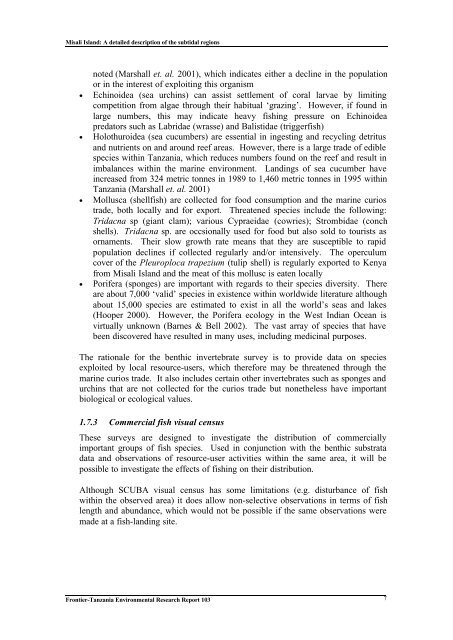Frontier-Tanzania Environmental Research REPORT 103 Misali Island
Frontier-Tanzania Environmental Research REPORT 103 Misali Island
Frontier-Tanzania Environmental Research REPORT 103 Misali Island
Create successful ePaper yourself
Turn your PDF publications into a flip-book with our unique Google optimized e-Paper software.
<strong>Misali</strong> <strong>Island</strong>: A detailed description of the subtidal regionsnoted (Marshall et. al. 2001), which indicates either a decline in the populationor in the interest of exploiting this organism• Echinoidea (sea urchins) can assist settlement of coral larvae by limitingcompetition from algae through their habitual ‘grazing’. However, if found inlarge numbers, this may indicate heavy fishing pressure on Echinoideapredators such as Labridae (wrasse) and Balistidae (triggerfish)• Holothuroidea (sea cucumbers) are essential in ingesting and recycling detritusand nutrients on and around reef areas. However, there is a large trade of ediblespecies within <strong>Tanzania</strong>, which reduces numbers found on the reef and result inimbalances within the marine environment. Landings of sea cucumber haveincreased from 324 metric tonnes in 1989 to 1,460 metric tonnes in 1995 within<strong>Tanzania</strong> (Marshall et. al. 2001)• Mollusca (shellfish) are collected for food consumption and the marine curiostrade, both locally and for export. Threatened species include the following:Tridacna sp (giant clam); various Cypraeidae (cowries); Strombidae (conchshells). Tridacna sp. are occsionally used for food but also sold to tourists asornaments. Their slow growth rate means that they are susceptible to rapidpopulation declines if collected regularly and/or intensively. The operculumcover of the Pleuroploca trapezium (tulip shell) is regularly exported to Kenyafrom <strong>Misali</strong> <strong>Island</strong> and the meat of this mollusc is eaten locally• Porifera (sponges) are important with regards to their species diversity. Thereare about 7,000 ‘valid’ species in existence within worldwide literature althoughabout 15,000 species are estimated to exist in all the world’s seas and lakes(Hooper 2000). However, the Porifera ecology in the West Indian Ocean isvirtually unknown (Barnes & Bell 2002). The vast array of species that havebeen discovered have resulted in many uses, including medicinal purposes.The rationale for the benthic invertebrate survey is to provide data on speciesexploited by local resource-users, which therefore may be threatened through themarine curios trade. It also includes certain other invertebrates such as sponges andurchins that are not collected for the curios trade but nonetheless have importantbiological or ecological values.1.7.3 Commercial fish visual censusThese surveys are designed to investigate the distribution of commerciallyimportant groups of fish species. Used in conjunction with the benthic substratadata and observations of resource-user activities within the same area, it will bepossible to investigate the effects of fishing on their distribution.Although SCUBA visual census has some limitations (e.g. disturbance of fishwithin the observed area) it does allow non-selective observations in terms of fishlength and abundance, which would not be possible if the same observations weremade at a fish-landing site.<strong>Frontier</strong>-<strong>Tanzania</strong> <strong>Environmental</strong> <strong>Research</strong> Report <strong>103</strong> 7
















